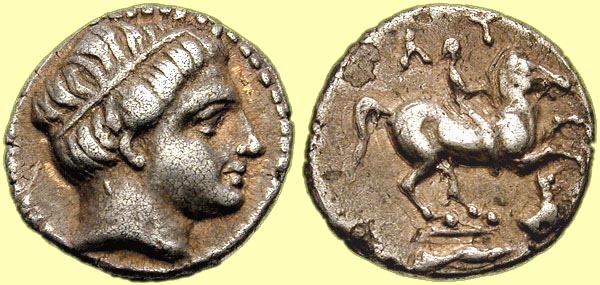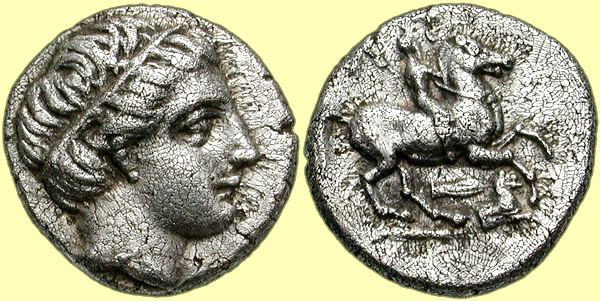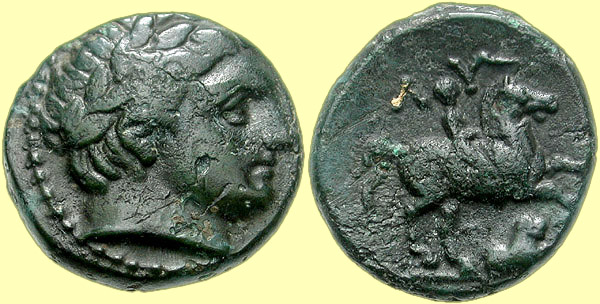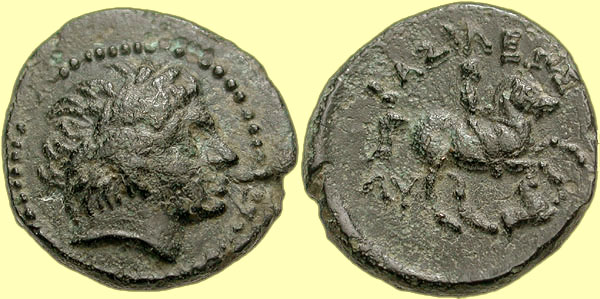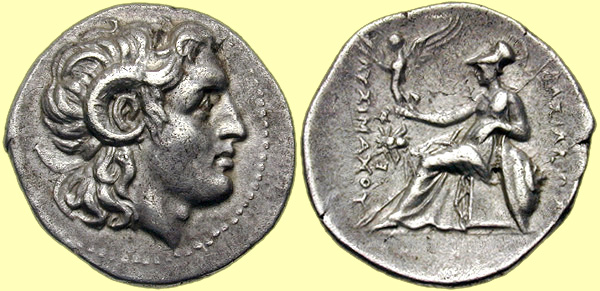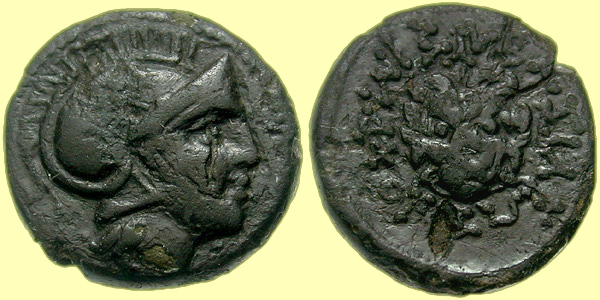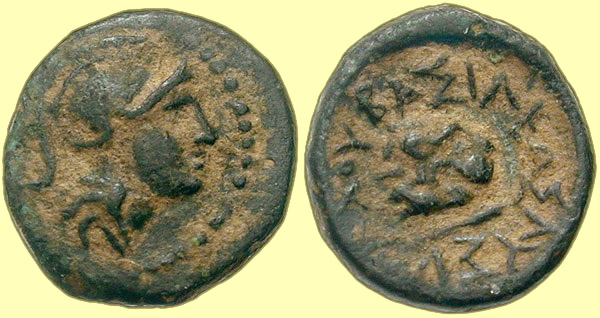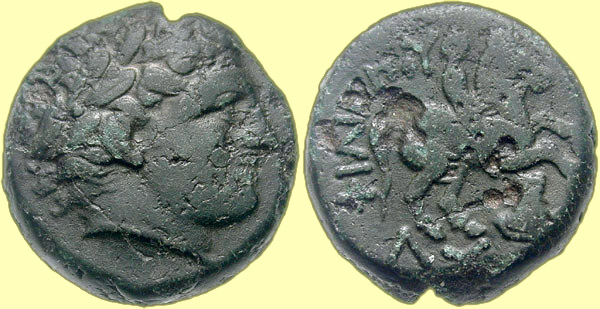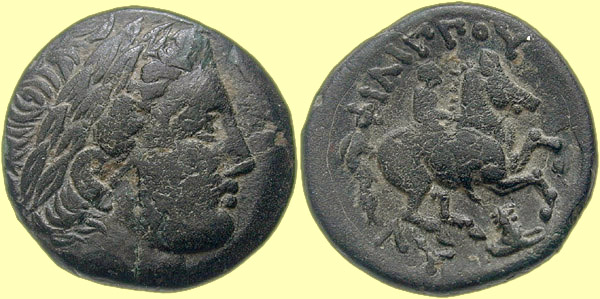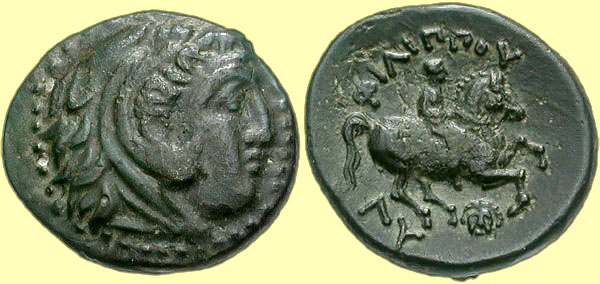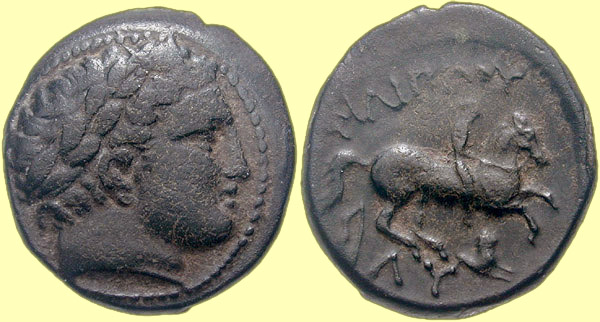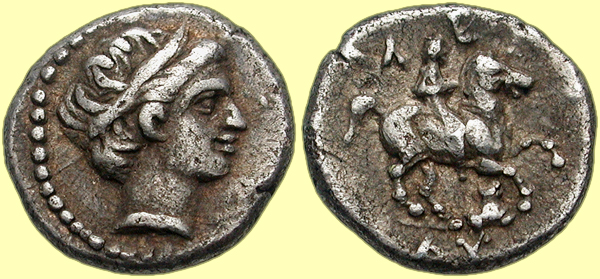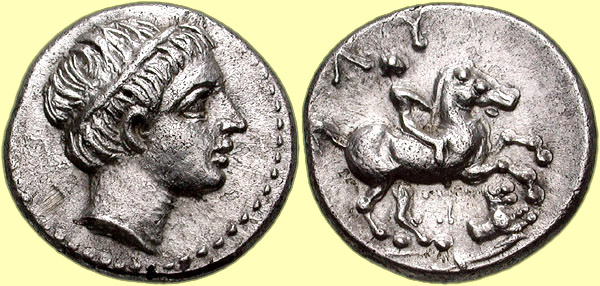Notes: The attribution of this coin type to Lysimachos is fairly certain. Two other issues, likely issued
earlier, provide a vital link. Those issues, like this one, appear to be a typical Fifth-Tetradrachms of Philip II type. One retains Philip's
name on the reverse, with LU and the lion forepart placed below the horse (Thompson 1; SNG ANS 829 (Philip II)). Thus, a positive connection
with the typical Philip II Fifths. Even more fascinating is the other issue, which on which Philip's name is replaced with Alexander's (Price
435; Winterthur 1585). There are also accompanying bronze issues for each of these types. As such, all of the references and collections
conclude that these coins were of Lysimachos.
In her study, Lysimachus: A Study in Early Hellenistic Kingship, Lund asserts that Lysimachos' pivotal victories against
Antigonos Monopthalamos won him recognition as the ruler of Thrace from his allies, the other Diodochs (Lund, 62). Therefore, it would certainly
not be incomprehensible that Lysimachos would have the wherewithal to issue coinage in his name. Perhaps his first issues with Philip's and
Alexander's name were trials to see how his contemporaries would react.
Comparatively, the earliest coinage of Ptolemy I to bear his name are tetradrachms issued circa 315-310 BC. These 'satrapal'
issues, while not of Alexander type, do bear both Alexander and Ptolemy's name (cf. SNG Copenhagen 13). Kassander, Lysimachos' ally in Macedon, also
issued coinage in his own name before 305 BC, the year when he, Ptolemy I, and Lysimachos all assumed the royal title 'Basilews'. In sum, each of
these Diodochs issued coinage in their own names after 305 BC, but they also did so before.
Although there is dissention among the sources as to the mint of origin, one theory is very persuasive. Lund and Price
connect this coinage with the close friendship between Lysimachos and Cassander that developed around 315 BC (Lund, 57; Price, p. 130). They (as well
as Thompson) contend that Cassander probably provided money for Lysimachos from Amphipolis, located near the border of their two territories. This would
explain the use of this type of coinage, which would be difficult to explain if Lysimachia were the actual mint of issue (as Thompson, Müller, and ANS
contend). Price doubts the possibility of Lysimachia as a mint for Lysimachos, especially early after it's founding in 309 BC. He notes that the
autonomous city coinage certainly dated near 309 has a style vastly different from the Lysimachos coinage attributed to Lysimachia that early (Price, p. 197).
Although impossible as yet to determine the exact dating of the issues, a few theories abound. Price places these issues during
the time c. 320-315 BC. Lund, however, makes a strong case that this coinage could not be possible until Cassander had Macedon's mints under his firm control
in c. 315 BC. In support, she notes that Lysimachos probably did not take active part in any major conflict outside Thrace between 319-315 BC due to the lack
of a money supplier following the death of his benefactor Antipater in 319 BC (Lund, 57). Thompson argues the beginning date of this coinage as 306/5 BC, when
Lysimachos adopted the royal title. Other than the fact that other Diodochs issued coinage with their name earlier than then, noted above, no references date any
of the Philip Fifth-Tetradrachm issues after 315 BC, for any mint. In addition, it would be very perplexing, in 306/5 BC, for Lysimachos to reintroduce a
coinage of the type of, and naming, Philip II, which had not been minted since 315, rather than simply using an Alexander III/2, type (notwithstanding the use of
Alexander's name also in the issue).
Adopting a beginning date of 315 BC, I would posit that the earliest issue, probably beginning in 315 BC, would be the one with
Philip's name on the coins. According to Le Rider and ANS, Amphipolis had been issuing the Philip II style Fifth-Tetradrachms up to 315 BC, and the style
of the latest examples is highly similar to that on these coins of Lysimachos. Therefore, it would be a matter of course for the mint to produce dies with
the new control marks. Further, I would posit the seemingly obvious: the issue with only Lysimachos' name is the last. In this issue, it is notible that
the name of Lysimachos has not only remained alone, but has been moved to the top of the reverse, exactly where the names of the other two kings had been
placed. This had to be done purposefully, and served to proclaim Lysimachos as among the rank of Philip and Alexander. As the coinage would likely have
been used to pay troops and mercenaries, the motivation behind such a policy is readily apparent.
My research has located four of this type containing Philip's name (one at ANS (=Thompson 1), two in Winterthur, one in Pozzi), one
containing Alexander's name (Winterthur), and nine with Lysimachos' name alone (four at the ANS, two in Winterthur, one at BMFA, two in Pozzi (but one of these
is at ANA), and one of unknown provenance in Sear's Greek Coins and their Values, vol. 2). These numbers lead me to hypothesize the meaning behind the
unprecedented issue with Alexander's name. If Lysimachos wished to place himself in the esteemed position of his much-honored predecessors, such an issue
could emphasize the implications of the impending issue with solely Lysimachos' name. Thus, Lysimachos would also display himself as a successor to Alexander
who was, in turn, the successor of Philip II. This, of course, would only be as the "successor as ruler of Thrace," not of the whole Macedonian empire of
Alexander. As his position as ruler was secured among his peers after the first war with Antigonos, c. 311 BC, now he was asserting his rule to his subjects
and army in Thrace.
A terminal date of the three-issue series is less certain, however, certain events may shed some light. The issue certainly would not
last past Lysimachos' assumption of the royal title. In this case a plausible timeframe for the issues, considering the scarcity of each in relation to one
another, would be: The first issue, with Philip II's name was minted c. 315-311 BC. The second, with Alexander's name, was a short issue minted c. 311. The
third and final issue, with Lysimachos' name only, minted c. 311-305 BC. All of the sources confirm that Lysimachos' good relations with Cassander was enduring
during this time.
The overall rarity of the coins in general suggest a far shorter timeframe than ten years. The only other possibility fitting the events
of the time, is a very short timeframe, perhaps conforming to the war with Antigonos, 315-311 BC. Lysimachos would have need of much money for his contribution to
the cause, and as his position among the Diodochs rose with his success, he could have exercised the same strategy I outlined above during this war. The only
problem with this theory would be that such would leave Lysimachos without a dependable source of coinage between 311-305 BC. Given the close friendship between
Cassander and Lysimachos, it would be difficult to believe Cassander would cut Lysimachos off, or that Lysimachos did not have any need during this time.
Another theory explaining the coinage remains, though: the coinage could have been issued contemporary with his Alexander types, as
fractional coinage. Such is plausible as the Philip II Fifth Tetradrachms were struck at mints under Alexander and the other Diodochs that were also simultaneously
striking Alexander-types and Philip II tetradrachms. The fact, however, that there is no evidence of Philip-type Fifths being minted after 315 BC renders this theory
highly unlikely.
|
|
